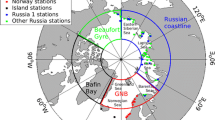Abstract
The recently published Third Assessment Reports of the Intergovernmental Panel on Climate Change have underlined the scientific interest in, and practical importance of past and potential future sea level changes. Space gravity missions will provide major benefits to the understanding of the past, and, thereby, in the prediction of future, sea level changes in many ways. The proposal for the GOCE mission described well the improvements to be expected from improved gravity field and geoid models in oceanography (for example, in the measurement of the time-averaged, or ‘steady state’, ocean surface circulation and better estimation of ocean transports), in geophysics (in the improvement of geodynamic models for vertical land movements), in geodesy (in positioning of tide gauge data into the same reference frame as altimeter data, and in improvement of altimeter satellite orbits), and possibly in glaciology (in improved knowledge of bedrock topography and ice sheet mass fluxes). GRACE will make many important steps towards these ‘steady state’ aims. However, its main purpose is the provision of oceanographic (and hydrological and meteorological) temporally-varying gravity information, and should in effect function as a global ‘bottom pressure recorder’, providing further insight into the 3-D temporal variation of the ocean circulation, and of the global water budget in general. This paper summaries several of these issues, pointing the way towards improved accuracy of prediction of future sea level change.
Similar content being viewed by others
References
Balmino, G., R. Rummel, P. Visser, and P. Woodworth: 1999, ‘Gravity Field and Steady-State Ocean Circulation Mission. Reports for assessment: the four candidate Earth Explorer Core Missions’, European Space Agency Report SP-1233(1). 217pp.
Bingley, R.M., A.H. Dodson, N.T. Penna, F.N. Teferle, and T.F. Baker: 2001, ‘Monitoring the vertical land movement component of changes in mean sea level using GPS: results from tide gauges in the UK’, Journal of Geospatial Engineering, 3, 9-20.
Cabanes, C., A. Cazenave, and C. Le Provost: 2001, ‘Sea level rise during past 40 years determined from satellite and in situ observations’, Science, 294, 840-842.
Cazenave, A., L. Soudarin, J-F. Cretaux, and C. Le Provost: 1999, ‘Sea level changes from Topex-Poseidon altimetry and tide gauges, and vertical crustal motions from DORIS’, Geophysical Research Letters, 26, 2077-2080.
Church, J.A., J.M. Gregory, P. Huybrechts, M. Kuhn, K. Lambeck, M.T. Nhuan, D. Qin, and P.L. Woodworth: 2001, ‘Changes in sea level’. In: J.T. Houghton, Y. Ding, D.J. Griggs, M. Noguer, P.J. Van Der Linden, X. Dai, K. Maskell, and C.A. Johnson (eds.): Climate Change 2001: The Scientific Basis, Contribution of Working Group I to the Third Assessment Report of the Intergovernmental Panel on Climate Change, Cambridge: Cambridge University Press, pp. 639-693.
Di Donato, G, A.M. Negredo, R. Sabadini, and L.L.A. Vermeersen: 1999, ‘Multiple processes causing sea-level rise in the central Mediterranean’, Geophysical Research Letters, 26, 1769-1772.
Douglas, B.C. and W.R. Peltier: 2002, ‘The puzzle of global sea-level rise’, Physics Today, 55(3), 35-40.
Ganachaud, A., C. Wunsch, M.-C. Kim, and B. Tapley: 1997, ‘Combination of TOPEX/Poseidon data with a hydrographic inversion for determination of the oceanic general circulation’, Geophysical Journal International, 128, 708-722.
GRACE, 1998. ‘Gravity Recovery and Climate Experiment science and mission requirements document’, Revision A, JPLD-15928, NASA's Earth System Science Pathfinder Program.
Gregory, J.M., J.A. Church, G.J. Boer, K.W. Dixon, G.M. Flato, D.R. Jackett, J.A. Lowe, S.P. O'Farrell, E. Roeckner, G.L. Russell, R.J. Stouffer, and M. Winton: 2001, ‘Comparison of results from several AOGCMs for global and regional sea-level change 1990–2100’, Climate Dynamics, 18, 225-240.
Le Grand, P. and J.-F. Minster: 1999, ‘Impact of the GOCE gravity mission on ocean circulation estimates’, Geophysical Research Letters, 26, 1881-1884.
Le Grand, P.: 2001, ‘Impact of the gravity field and steady-state ocean circulation explorer (GOCE) mission on ocean circulation estimates. Volume fluxes in a climatological inverse model of the Atlantic’, Journal of Geophysical Research, 106, 19597-19610.
Mitchum, G.T., R. Cheney, L.-L. Fu, C. Le Provost, Y. Menard, and P. Woodworth: 2001, ‘The future of sea surface height observations’. In: C.J. Koblinsky and N.R. Smith (eds.): Oceans in the 21st Century, Melbourne, Australia: Bureau of Meteorology, pp. 120-136.
NRC, 1997, ‘Satellite gravity and geosphere’, Washington, D.C.: National Academy Press.
Peltier, W.R.: 2001, ‘Global glacial isostatic adjustment’. In: B.C. Douglas, M.S. Kearney, and S.P. Leatherman (eds.): Sea level rise: history and consequences, San Diego: Academic Press, pp. 65-95.
Plag, H.-P. and H.-U. Jüttner: 2001, ‘Inversion of global tide gauge data for present-day ice load changes’. In: T. Yamanouchi (ed.): Proceedings of the Second International Symposium on Environmental Research in the Arctic and Fifth Ny-Alesund Scientific Seminar, Memoirs of the National Institute of Polar Research, Special Issue No. 54, 301-317.
Raper, S.C.B., J.M. Gregory, and R.J. Stouffer: 2002, ‘The role of climate sensitivity and ocean heat uptake on AOGCM transient temperature response’, Journal of Climate, 15, 124-130.
Schröter, J., M. Losch, and B. Sloyan: 2002, ‘Impact of the Gravity Field and Steady-State Ocean Circulation Explorer (GOCE) mission on ocean circulation estimates 2. Volume and heat fluxes across hydrographic sections of unequally spaced stations’, Journal of Geophysical Research, 107, 10.1029/2000JC000647.
Tamisiea, M.E., J.X. Mitrovica, G.A. Milne, and J.L. Davis: 2001, ‘Global geoid and sea level changes due to present-day ice mass fluctuations’, Journal of Geophysical Research, 106, 30849-30863.
Williams, S.D.P., T.F. Baker, and G. Jeffries: 2001, ‘Absolute gravity measurements at UK tide gauges’, Geophysical Research Letters, 28, 2317-2320.
Woodworth, P.L.: 1991, ‘The Permanent Service for Mean Sea Level and the Global Sea Level Observing System’, Journal of Coastal Research, 7, 699-710.
Woodworth, P.L., M.N. Tsimplis, R.A. Flather, and I. Shennan: 1999, ‘A review of the trends observed in British Isles mean sea level data measured by tide gauges’, Geophysical Journal International, 136, 651-670.
Author information
Authors and Affiliations
Rights and permissions
About this article
Cite this article
Woodworth, P.L., Gregory, J.M. V: SEA LEVEL: Benefits of GRACE and GOCE to sea level studies. Space Science Reviews 108, 307–317 (2003). https://doi.org/10.1023/A:1026179409924
Issue Date:
DOI: https://doi.org/10.1023/A:1026179409924




